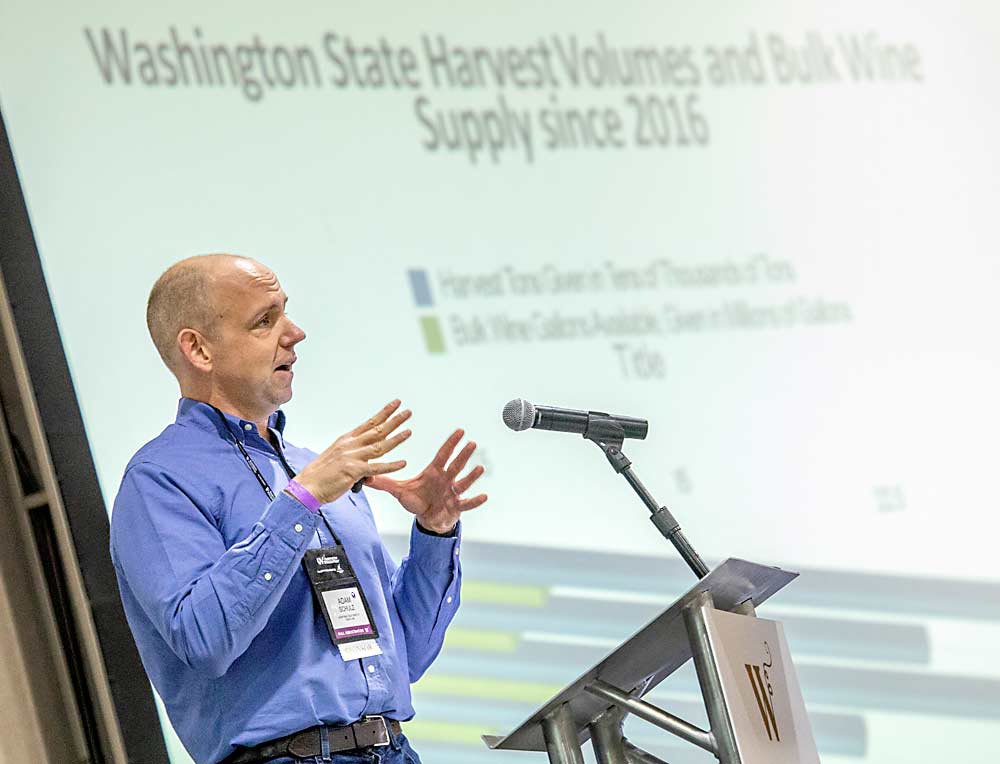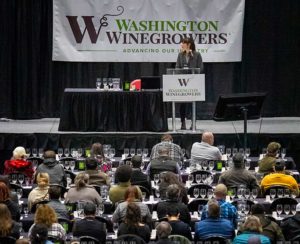
Bulk wine prices in Washington have climbed as out-of-state winemakers come to shop, while loosening pandemic restrictions have restored some on-premise demand and loyal drinkers seem to be trading up for more expensive bottles.
That’s the good news for the Washington wine industry, according to market experts during the “State of the Industry” session of WineVit, the convention marketed and organized by the Washington Winegrowers Association, held in early February.
“We’re starting to see a trend of more market acceptance” of Washington wines, said Adam Schulz, owner and founder of Incredible Bulk Wine Co. of Richland, Washington.
The bad news? Wine continues to lose ground in the retail market to spirits, and sales of bottles in the most common price ranges are dropping.
“Those are some challenging consumer trends,” said Steve Fredricks, president of Turrentine Brokerage of Novato, California.
Meanwhile, any rise in demand comes with a question mark after historically small Washington crops.
“It’s hard to say if it’s all based on market acceptance or if it’s based on short crop loads,” Schulz said.
Washington’s bulk wine inventories spiked to more than 12 million gallons in 2018, at the tail end of what the industry considers a period of oversupply, Schulz said. Since then, growers have been removing acreage, while frost and heat, respectively, led to short crops in 2020 and 2021. Last year, Washington produced only about 200,000 gallons of bulk wine.
Most of the supply and price shifts have come from Cabernet and other reds. Bulk red prices were about $7.50 per gallon in 2018 but doubled that by the end of 2021, he said.
For the 2022 vintage, the state may face some oversupply of reds, Schulz said, but the state also has more mid-sized wineries than it did 10 years ago, and those may be able to soak up some of that excess and diversify the market.
“That’s some of the opportunity I see,” he said in a follow-up interview with Good Fruit Grower.
Fredricks of Turrentine painted a global picture of supply gradually coming in line with demand after an effort in 2019 and 2020 to remove acreage and deliver less volume to wineries, driving up some bulk prices. Droughts in 2020 and 2021 brought supply even lower, while the pandemic and subsequent shipping challenges muddied the waters.
“We’ve moved past excess, but where are we in the supply and demand balance?” he said.
Sales of wine in two key price points — $8 to $12 and $12 to $15 — have been dropping or flat over the past two years. Those categories were growing before the pandemic struck.
“Key varietal and price point trends for the wine business are not positive for the past 12 months,” he said.
High-priced wine sales, on the other hand, have been growing for many years, as existing consumers trade up. In 2021, bottles selling for $50 or more jumped 47 percent over the previous year, he said.
Local reaction
Part of that spike in high prices is due to the pandemic, said Juan Muñoz-Oca, chief winemaker for Ste. Michelle Wine Estates, Washington’s largest winery. But, overall, the current balance of supply and demand is healthy for the state’s industry, he said. It has given the state a role in the global bulk market, something it didn’t have just a few years ago.

“We are evolving into an industry that is participating in this global dynamic,” Muñoz-Oca said.
And he agreed the extra inventory that Schulz expects could help. It gives winemakers insurance against unpredictable weather and helps Washington maintain that growing global market share, he said.
Some of the national and global trends play out for Washington producers, but not all of them, said Scott Williams, proprietor of Kiona Vineyards and Winery in Benton City and a Washington Winegrowers board member. Other than a few giants, most Washington wineries are small and cater to the high-end market.
“We don’t really play in that field at all,” —Williams said in a follow-up interview with Good Fruit Grower.
Kiona has seen an increase in on-premise sales, but they come from customers sitting at tables rather than bar-style tastings, due to lingering pandemic restrictions. That meant room for fewer customers, but they were more loyal and were willing to pay higher prices than the tasters, he said.
He also blames rising production costs for some shifting trends. For example, his bottle prices have doubled recently; those types of hikes disproportionately affect the midrange bottles that are seeing shrinking sales.
Jeff Andrews, managing partner of Andrews Family Vineyards south of Prosser, has seen a huge increase in demand for his fruit the past two years, in particular the “boutique market” Washington is known for, he said. Andrews also is a Washington Winegrowers board member.
Washington doesn’t have nearly the volume of bulk wine as California, but what it does have has been selling well, said Becca De Kleine, general manager and director of winemaking for Four Feathers Wine Services, a bulk and custom wine producer in Prosser that also makes its own labeled wines. The industry is just now benefitting from the two small vintages, and will for another year or two, she said.
“I think it’s a great time for bulk wine,” said De Kleine, another Washington Winegrowers board member. “Supply is low, and quality is extremely high.”
The swing toward high-priced wine is good overall for the industry, she said, so long as it continues to reach out to less sophisticated consumers lured by hard seltzers and other competing products. They need a lower-priced entry point if they are going to buy wine. “Ensuring that wine stays relevant and not too expensive and unapproachable,” she said.
—by Ross Courtney









Leave A Comment